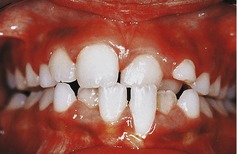Case• 51. Anterior crossbite
SUMMARY
An 8-year-old girl is referred to you for an orthodontic opinion. She has an anterior crossbite. What is the cause and how would you treat it?
History
Complaint
The mother of the patient noticed the crossbite and is very anxious about her daughter’s appearance. She requested a referral from the family’s general dental practitioner.
History of complaint
The incisors erupted into their present positions and there is no history of trauma.
Medical history
The patient is fit and healthy.
Examination
Extraoral examination
There is no facial asymmetry and no clicks, locking or crepitus are present on examination of the temporomandibular joints.
Intraoral examination
▪ The appearance of the teeth on presentation is shown inFigure 51.1. What do you see?
The patient is in the early mixed dentition stage and the teeth present are:


The upper and lower incisors are crowded and the upper left central and lateral incisors are in crossbite. The lower left central incisor is labially placed and there is gingival recession and loss of attached gingiva to the mucogingival junction on its labial aspect. The oral hygiene is reasonable though mild interdental gingivitis is present around the poorly aligned incisors. The dental health is good.
▪ What specific feature would you check in your examination? Explain why for each.
See Table 51.1.
| Feature | Reason |
|---|---|
| Can the patient achieve an edge-to-edge incisor relationship when closing on hinge axis? |
On closing in a retruded position the patient makes initial contact on the lower left central incisor.
If left untreated this could result in continued excessive occlusal loading on this tooth, causing further loss of support.
The ability to achieve incisal contact is regarded as favourable because it indicates that minimal tooth movement should be required to correct the crossbite.
|
| If so, is there an associated forward displacement of the mandible? |
The initial contact on the central incisors displaces her mandible forwards into the intercuspal position shown in Figure 51.1. Early correction of the displacement activity may prevent possible temporomandibular joint dysfunction in later life.
There is not yet significant wear faceting on the incisors. However, if they are left untreated, considerable attritional wear may develop.
|
| How mobile is the lower left central incisor? Are probing depths increased? | Mobility is limited (grade 1) and probing depths /> |
Stay updated, free dental videos. Join our Telegram channel

VIDEdental - Online dental courses



